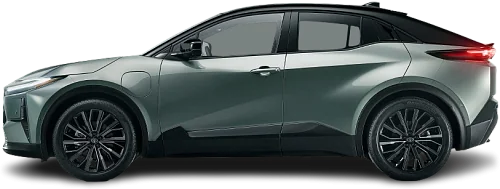Global EV Comparison: Kia EV5 Standard Range FWD vs Toyota C-HR+ 77 kWh FWD
Struggling to Decide? Let AI Help!
Your AI Summary Is Ready!
General Info
Although both vehicles have been announced, they are not yet in production and will not be available for sale in Europe.
The two vehicles share the same body style: SUV.
| Property | Kia EV5 Standard Range FWD | Toyota C-HR+ 77 kWh FWD |
|---|---|---|
| Years of Production | 2026-… | 2025-… |
| Current Status | Announced | Announced |
| Country of Manufacture | South Korea | Japan, China |
| Body Style | SUV | SUV |
| Market Availability | EU | EU, USA |
| GCC Score | 6.7 | 6.6 |
Range and Efficiency
Even though the Toyota C-HR+ 77 kWh FWD (2025-…) has a larger battery, the Kia EV5 Standard Range FWD (2026-…) higher energy efficiency results in a longer real-world driving range.
| Property | Kia EV5 Standard Range FWD | Toyota C-HR+ 77 kWh FWD |
|---|---|---|
| Range (EPA) | 644 km | - Range (EPA) |
| Range (WLTP) | - Range (WLTP) | 600 km |
| Range (GCC) | 612 km | 510 km |
| Battery Capacity (Nominal) | 60.3 kWh | 77 kWh |
| Battery Capacity (Usable) | 57.3 kWh | 69.3 kWh |
| Efficiency per 100 km | 9.4 kWh/100 km | 13.6 kWh/100 km |
| Efficiency per kWh | 10.68 km/kWh | 7.36 km/kWh |
| Range and Efficiency Score | 10 | 9.6 |
Charging
The Kia EV5 Standard Range FWD (2026-…) features an advanced 800-volt architecture, whereas the Toyota C-HR+ 77 kWh FWD (2025-…) relies on a standard 400-volt system.
The Toyota C-HR+ 77 kWh FWD (2025-…) offers faster charging speeds at DC stations, reaching up to 150 kW, while the Kia EV5 Standard Range FWD (2026-…) maxes out at 102 kW.
The Toyota C-HR+ 77 kWh FWD (2025-…) features a more powerful on-board charger, supporting a maximum AC charging power of 11 kW, whereas the Kia EV5 Standard Range FWD (2026-…) is limited to 6.6 kW.
| Property | Kia EV5 Standard Range FWD | Toyota C-HR+ 77 kWh FWD |
|---|---|---|
| Max Charging Power (AC) | 6.6 kW | 11 kW |
| Max Charging Power (DC) | 102 kW | 150 kW |
| Architecture | 800 V | 400 V |
| Charge Port | CCS Type 2 | CCS Type 2 |
| Charging Score | 4.9 | 6.4 |
Performance
Both vehicles are front-wheel drive.
The Toyota C-HR+ 77 kWh FWD (2025-…) boasts greater motor power and accelerates faster from 0 to 100 km/h.
| Property | Kia EV5 Standard Range FWD | Toyota C-HR+ 77 kWh FWD |
|---|---|---|
| Drive Type | FWD | FWD |
| Motor Type | PMSM | PMSM |
| Motor Power (kW) | 160 kW | 165 kW |
| Motor Power (hp) | 215 hp | 221 hp |
| Motor Torque | 310 Nm | 300 Nm |
| 0-100 km/h | 8.5 s | 7.4 s |
| Top Speed | 185 km/h | 160 km/h |
| Performance Score | 3.7 | 3.5 |
Dimensions
The Kia EV5 Standard Range FWD (2026-…) is longer and taller, but about the same width as the Toyota C-HR+ 77 kWh FWD (2025-…).
Both models have similar wheelbase lengths.
| Property | Kia EV5 Standard Range FWD | Toyota C-HR+ 77 kWh FWD |
|---|---|---|
| Length | 4615 mm | 4520 mm |
| Width (w/o Mirrors) | 1875 mm | 1870 mm |
| Height | 1715 mm | 1595 mm |
| Wheelbase | 2750 mm | 2750 mm |
Cargo and Towing
A frunk (front trunk) is available in the Kia EV5 Standard Range FWD (2026-…), but the Toyota C-HR+ 77 kWh FWD (2025-…) doesn’t have one.
The Toyota C-HR+ 77 kWh FWD (2025-…) is better suited for heavy loads, offering a greater towing capacity than the Kia EV5 Standard Range FWD (2026-…).
| Property | Kia EV5 Standard Range FWD | Toyota C-HR+ 77 kWh FWD |
|---|---|---|
| Number of Seats | 5 | 5 |
| Curb Weight | 1948 kg | - Curb Weight |
| Cargo Volume (Trunk) | 513 l | 416 l |
| Cargo Volume (Max) | 1714 l | - Cargo Volume (Max) |
| Cargo Volume (Frunk) | 67 l | - Cargo Volume (Frunk) |
| Towing Capacity | 300 kg | 750 kg |
| Cargo and Towing Score | 7.6 | 6.3 |




